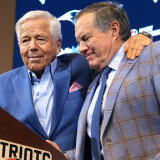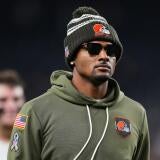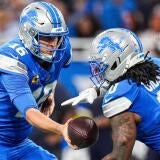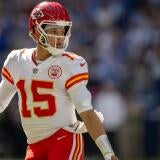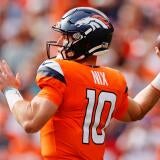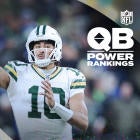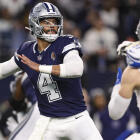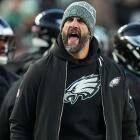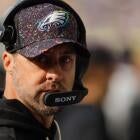
Is Jeremy Maclin the final piece to the Ravens' passing-game puzzle?
Maclin battled injuries last season but he's one of the NFL's most reliable pass catchers

When you think of the Ravens, the first thing that comes to mind is defense. Never mind that Ray Lewis, the future Hall of Famer and the second draft pick in team history, retired in 2012, and that the team has been the model of mediocrity in the four seasons since (they're 31-33 over that time, to be precise).
What you don't think about is the offense, and for good reason: Since the team drafted Joe Flacco in 2008, here's where the offense has ranked, according to Football Outsiders' metrics:
| YEAR | OVERALL | RUSH RANK | PASS RANK |
| 2008 | 19th | 9th | 20th |
| 2009 | 9th | 4th | 11th |
| 2010 | 12th | 13th | 8th |
| 2011 | 13th | 10th | 14th |
| 2012 | 13th | 7th | 15th |
| 2013 | 30th | 32nd | 24th |
| 2014 | 9th | 18th | 6th |
| 2015 | 20th | 18th | 21st |
| 2016 | 24th | 21st | 26th |
The general takeaway: For the last decade this has been an average unit that struggles more through the air than on the ground. Twenty years ago, a team could work around that. Look no further than ... the Ravens, who won the 2000 Super Bowl with one of the best defenses of the modern era in an offense that "featured" Tony Banks and Trent Dilfer under center but relied on running backs Jamal Lewis and Priest Holmes. The leading receiver on that team? Tight end Shannon Sharpe, who had 810 receiving yards. Behind him: Qadry Ismail and his 655 receiving yards. By comparison, the Jets had the worst offense in 2016 and their two leading receivers were Quincy Enunwa (857 yards) and Brandon Marshall (788 yards).
But it's not as if the Ravens haven't tried to adjust to a league that has become more reliant on the forward pass; the team wanted Byron Leftwich in 2003 and when the Jaguars drafted him first, they settled on strong-armed Kyle Boller. That obviously didn't work out, and five years later, they used a first-round pick on Flacco, who has started all but six games in his NFL career and led the team to five straight postseason appearances to begin his career, including a Super Bowl title in February 2013.
The club has also tried to surround Flacco with playmakers; through the draft there have been Ed Dickson and Dennis Pitta in 2010, Torrey Smith in 2011, Crocket Gillmore in 2014, and Breshad Perriman and Maxx Williams in 2015. In free agency, there have been Anquan Bolden and Donté Stallworth in 2010, Lee Evans in 2011, Jacoby Jones in 2012, Steve Smith and Owen Daniels in 2014, Mike Wallace in 2016, and most recently: Jeremy Maclin, who was signed with the Ravens just last week.
This is where we point out that since Flacco arrived in Baltimore, the Ravens have never had two 1,000-yard receivers in a season. Will Maclin's addition change that?
That's the two-year, $11 million question. On the surface, it certainly seems plausible. The expectation is that Wallace and Perriman will man the outside while Maclin will work the slot, much in the same vein as his predecessor, Steve Smith. But last season, only Wallace cracked 1,000 yards. Smith finished with 799 yards in 14 games while Perriman was limited to just 499 yards on 33 catches. Interestingly, Smith has a higher yards-per-catch career average than Maclin (14.3 YPC vs. 13.5 YPC). Team's don't get extra credit for having multiple 1,000-yard receivers, but it does indicate a balanced offense that isn't reliant on just one or two players, and that makes a defense's job all the more difficult.
So what can we expect from Maclin?
A year ago, Flacco was most effective in passes thrown 10-19 yards downfield, either in the middle of the field or to his right. In fact, these were the only two locations where Flacco graded positively, according to Pro Football Focus' grades. Some of that success was because of Pitta, who had 86 receptions for 729 yards last season. But he was released earlier this month after a career-threatening hip injury. The good news is that the Ravens are stocked at tight end; Gillmore, Williams, Nick Boyle and Benjamin Watson are all capable. The even-better news is that Flacco also leaned heavily on his slot receiver, of which Maclin is now one.
Last season, Maclin ranked 50th among all wideouts in working from the slot but there's an important caveat: He missed a month with a groin injury and it hampered his productivity. But in 2015, when he started 15 games and had 87 catches for 1,088 yards and 8 touchdowns, Maclin was much more efficient in the slot: He ranked sixth in catch rate -- behind the likes of Tyler Lockett, Doug Baldwin, Larry Fitzgerald and Danny Amendola -- hauling in 79 percent of the passes thrown in his direction. Added bonus: Six of his eight scores came when he was in the slot.
The hope is that Maclin, who is now healthy, can replicate his 2015 success. Smith, for what it's worth, ranked 22nd among slot receivers last season.
Wallace, who was high on the Ravens' receivers before Maclin arrived, feels really good about this group now.
"I was totally confident like I told you when I first got here in the spring. I was excited about our guys then," Wallace said last week, via ESPN.com. "Any time you can add a guy like [Maclin], I say even better. I think we're going to have a great receiving corps. You add a guy who has had some 1,000-yard seasons, Pro Bowl, you can't ask for much more than that."
Ravens offensive coordinator Marty Mornhinweg agreed.
"First of all, he's gifted," Mornhinweg said. "He's talented. He's smart. He's natural. He's smooth. He has outstanding hands. He's tough, so he's got a lot of great, great qualities. The one that popped into my mind first was consistency. He plays at a high level on a consistent basis. He plays like a Raven. That's the way we want to play."
Mornhinweg isn't blowing smoke; in 2015, Maclin had one drop in 120 targets, which was tops -- by a large margin -- among wideouts. He also makes those around him better; that same season, quarterbacks had a 115.6 rating when throwing in his direction, which ranked 10th among all wideouts. Oh, and Maclin's not just a middle-of-the-field target; he's a deep threat too. He ranked 15th in '15 in deep passing -- ahead of Torrey Smith, Stefon Diggs and Antonio Brown -- going 8 for 8 on balls thrown more than 20 yards downfield.
Put another way: Maclin made too much sense for the Ravens not to sign him. And the feeling was mutual.
"When I got a chance to come here and meet all the guys and meet all the coaches, it just felt right," Maclin said last week after his first practice with the team. ... "With me coming here and what was already here, I felt like this was a team that could definitely win and definitely build something special. From a football standpoint, it made the most sense."
If Wallace continues to produce and 2015 first-rounder Perriman can finally live up to his potential, the Ravens' offense could be formidable. And Wallace, who is entering his second year in Baltimore, sees big things for Perriman in 2017.
"He's going to surprise a lot of people," Wallace said last month. "He's going to be one of the top receivers in the league this year. ... You can tell it's night and day with the confidence level. I know exactly how he's going to play. I'm the most confident person in him in the whole world."
Flacco and Mornhinweg will settle for one of the top receivers on the team. Because if Perriman, Wallace and Maclin are all playing well, that means the offense can be two-dimensional, something the team hasn't been able to say in years.



